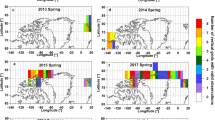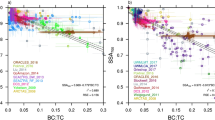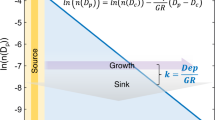Abstract
Black carbon is generated by fossil-fuel combustion and biomass burning. Black-carbon aerosols absorb solar radiation, and are probably a major source of global warming1,2. However, the extent of black-carbon-induced warming is dependent on the concentration of sulphate and organic aerosols—which reflect solar radiation and cool the surface—and the origin of the black carbon3,4. Here we examined the impact of black-carbon-to-sulphate ratios on net warming in China, using surface and aircraft measurements of aerosol plumes from Beijing, Shanghai and the Yellow Sea. The Beijing plumes had the highest ratio of black carbon to sulphate, and exerted a strong positive influence on the net warming. Compiling all the data, we show that solar-absorption efficiency was positively correlated with the ratio of black carbon to sulphate. Furthermore, we show that fossil-fuel-dominated black-carbon plumes were approximately 100% more efficient warming agents than biomass-burning-dominated plumes. We suggest that climate-change-mitigation policies should aim at reducing fossil-fuel black-carbon emissions, together with the atmospheric ratio of black carbon to sulphate.
This is a preview of subscription content, access via your institution
Access options
Subscribe to this journal
Receive 12 print issues and online access
$259.00 per year
only $21.58 per issue
Buy this article
- Purchase on Springer Link
- Instant access to full article PDF
Prices may be subject to local taxes which are calculated during checkout



Similar content being viewed by others
References
Jacobson, M. Z. Strong radiative heating due to the mixing state of black carbon in atmospheric aerosols. Nature 409, 695–697 (2001).
Ramanathan, V. & Carmichael, G. Global and regional climate changes due to black carbon. Nature Geosci. 1, 221–227 (2008).
Jacobson, M. Z. Control of fossil-fuel particulate black carbon and organic matter, possibly the most effective method of slowing global warming. J. Geophys. Res. 107, 4410 (2002).
Forster, P. et al. in Climate Change 2007: The Physical Science Basis—Contribution of Working Group I to the Fourth Assessment Report of the Intergovernmental Panel on Climate Change (eds Solomon, S. et al.) (Cambridge Univ. Press, 2007).
Jacobson, M. Z. The short-term cooling but long-term global warming due to biomass burning. J. Clim. 17, 2909–2926 (2004).
Jacobson, M. Z. Climate response of fossil fuel and biofuel soot, accounting for soot’s feedback to snow and sea ice albedo and emissivity. J. Geophys. Res. 109, D21201 (2004).
Bond, T. C. Can warming particles enter global climate discussions? Environ. Res. Lett. 2, 045030 (2007).
Guazzotti, S. A., Coffee, K. R. & Prather, K. A. Continuous measurements of size-resolved particle chemistry during INDOEX-Intensive Field Phase 99. J. Geophys. Res. 106, 28607–28628 (2001).
Moffet, R. C. & Prather, K. A. In-situ measurements of the mixing state and optical properties of soot with implications for radiative forcing estimates. Proc. Natl Acad. Sci. 106, 11872–11877 (2009).
Novakov, T. et al. Origin of carbonaceous aerosols over the tropical Indian Ocean: Biomass burning or fossil fuels? Geophys. Res. Lett. 27, 695–697 (2001).
Ramanathan, V. et al. Atmospheric brown clouds: Hemispherical and regional variations in long range transport, absorption, and radiative forcing. J. Geophys. Res. 112, D22S21 (2007).
United Nations Environment Programme Independent Environmental Assessment: Beijing 2008 Olympic Games. (UNEP, 2009). Data are available at http://mic.greenresource.cn/olympic; Emission inventory prepared by Argonne National Laboratory and Tsinghau University.
Ramanathan, V. et al. Warming trends in Asia amplified by brown cloud solar absorption. Nature 448, 575–578 (2007).
Zhang, Q. et al. Asian emissions in 2006 for the NASA INTEX-B mission. Atmos. Chem. Phys. 9, 5131–5153 (2009).
Ramana, M. V., Ramanathan, V., Kim, D., Roberts, G. C. & Corrigan, C. E. Albedo, atmospheric solar absorption and heating rate measurements with stacked UAVs. Q. J. R. Meteorol. Soc. 133, 1913–1931 (2007).
Bond, T. C. et al. A technology-based global inventory of black and organic carbon emissions from combustion. J. Geophys. Res. 109, D14203 (2004).
Gustafsson, O. et al. Brown clouds over South Asia: Biomass or fossil fuel combustion? Science 323, 495–498 (2009).
Sheesley, R. J., Schauer, J. J., Zheng, M. & Wang, B. Sensitivity of molecular marker-based CMB models to biomass burning source profiles. Atmos. Environ. 41, 9050–9063 (2007).
Lough, G. C. & Schauer, J. J. Sensitivity of source apportionment of urban particulate matter to uncertainty in motor vehicle emission profiles. J. Air Waste Manage. Assoc. 57, 1200–1213 (2007).
Ito, A. & Penner, J. E. Historical emissions of carbonaceous aerosols from biomass and fossil fuel burning for the period 1870–2000. Glob. Biochem. Cycles 19, GB2028 (2005).
Olivier, J. G. J., Van Aardenne, J. A., Dentener, F., Ganzeveld, L. & Peters, J. A. H. W. in Non-CO2 Greenhouse Gases (NCGG-4) (ed. van Amstel, A. (coord.)) 325–330 (Mill Press, 2005).
Smith, S. J., Andres, R., Conception, E. & Lurz, J. Historical Sulfur Dioxide Emissions 1850–2000: Methods and Results, JGCRI Report. PNNL-14537 (Pacific Northwest National Laboratory, 2004).
Menon, S. et al. Black carbon aerosols and the third polar ice cap. Atmos. Chem. Phys. Discuss. 9, 26593–26625 (2009).
Lau, K-M. et al. The Joint Aerosol–Monsoon Experiment: A new challenge for monsoon climate research. Bull. Am. Meterol. Soc. 89, 1–5 (2008).
Smith, K. R. In praise of petroleum, editorial. Science 298, 1847 (2002).
Corrigan, C. E., Roberts, G. C., Ramana, M. V., Kim, D. & Ramanathan, V. Capturing vertical profiles of aerosols and black carbon over the Indian Ocean using autonomous unmanned aerial vehicles. Atmos. Chem. Phys. 8, 737–747 (2008).
Schauer, J. J. et al. ACE–Asia intercomparison of a thermal-optical method for the determination of particle-phase organic and elemental carbon. Environ. Sci. Technol. 37, 993–1001 (2003).
Andreae, M. O. & Gelencser, A. Black carbon or brown carbon? The nature of light-absorbing carbonaceous aerosols. Atmos. Chem. Phys. 6, 3131–3148 (2006).
Streets, D. G. et al. Anthropogenic and natural contributions to regional trends in aerosol optical depth, 1980–2006. J. Geophys. Res. 114, D00D18 (2009).
Acknowledgements
The CAPMEX campaign was supported by NSF under grant ATM-0836093, and the analyses were funded by NSF grant ATM-0721142 and by NOAA grant NOAA/NA17RJ1231. We thank H. Nguyen for his support and the flight crew from Advanced Ceramic Research for the field support. We are grateful to Korean Air and their staff at Jeongseok Airport for their generous hospitality. S-C.Y. was supported by the Korean Meteorological Administration R&D programmes under grant CATER 2006-4104, and the BK21 program in the School of Earth and Environmental Sciences, Seoul National University. We thank J. Fein, M. Rezin, S. C. Park, M. H. Kim, E. A. Stone and J. DeMinter for their support in conducting the campaign. We would like to acknowledge Cheju Aviation Management Office for their support of the field campaign.
Author information
Authors and Affiliations
Contributions
M.V.R. collected the data and carried out the bulk of the analysis with major input from V.R., V.R. designed CAPMEX and provided project oversight, Y.F. was responsible for emission-data analysis, Gosan surface data were synthesized by S-C.Y. and S-W.K., G.R.C. was responsible for the emission data during the Olympics and J.J.S. was responsible for aerosol filter-sampling analysis. V.R and M.V.R. wrote the manuscript, with input from Y.F., S-C.Y., S-W.K., G.R.C. and J.J.S.
Corresponding author
Ethics declarations
Competing interests
The authors declare no competing financial interests.
Supplementary information
Supplementary Information
Supplementary Information (PDF 730 kb)
Rights and permissions
About this article
Cite this article
Ramana, M., Ramanathan, V., Feng, Y. et al. Warming influenced by the ratio of black carbon to sulphate and the black-carbon source. Nature Geosci 3, 542–545 (2010). https://doi.org/10.1038/ngeo918
Received:
Accepted:
Published:
Issue Date:
DOI: https://doi.org/10.1038/ngeo918
This article is cited by
-
The effect of local pollution and transport dust on near surface aerosol properties over a semi-arid station from ground and satellite observations
Air Quality, Atmosphere & Health (2024)
-
Air quality characteristics during 2016–2020 in Wuhan, China
Scientific Reports (2023)
-
Radiative forcing bias calculation based on COSMO (Core-Shell Mie model Optimization) and AERONET data
npj Climate and Atmospheric Science (2023)
-
Variations in mixing states of organic aerosol composition and formation of secondary organic aerosol at background region
Journal of Atmospheric Chemistry (2023)
-
Unified theoretical framework for black carbon mixing state allows greater accuracy of climate effect estimation
Nature Communications (2023)



